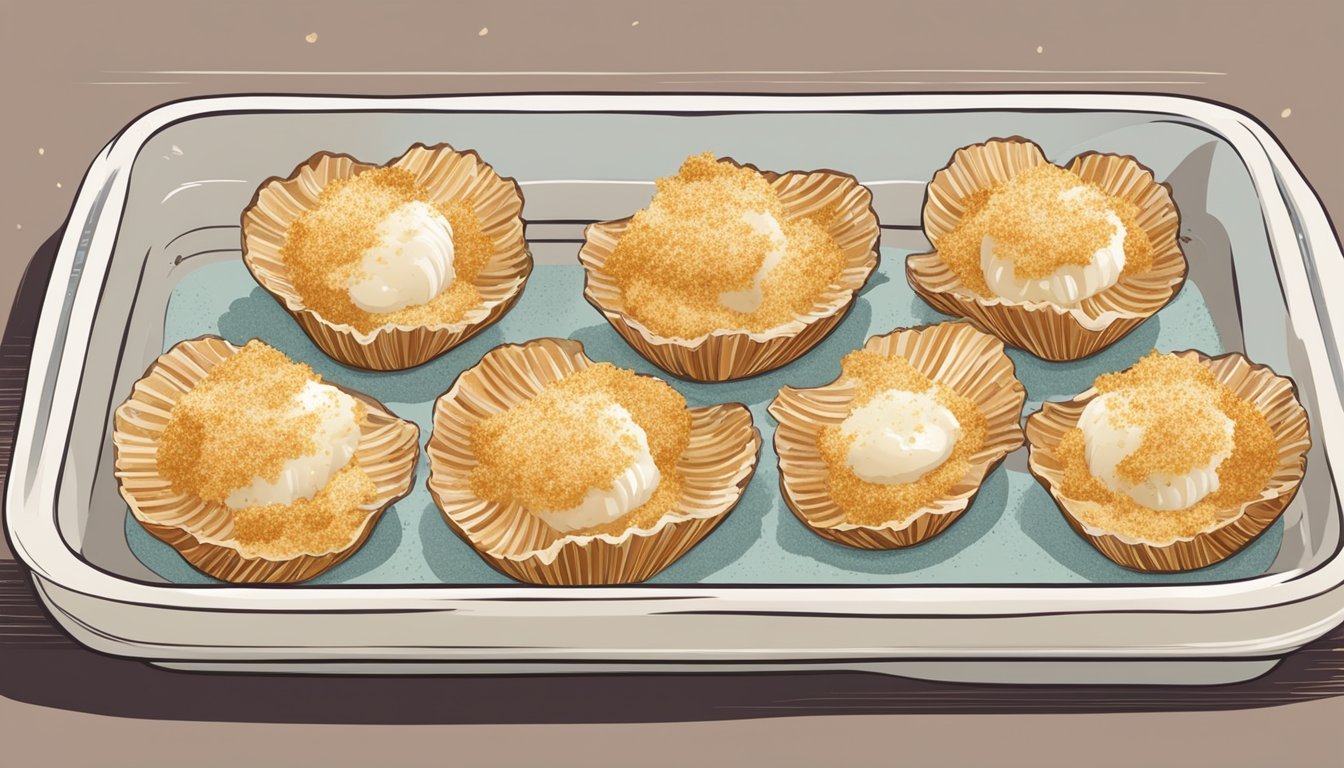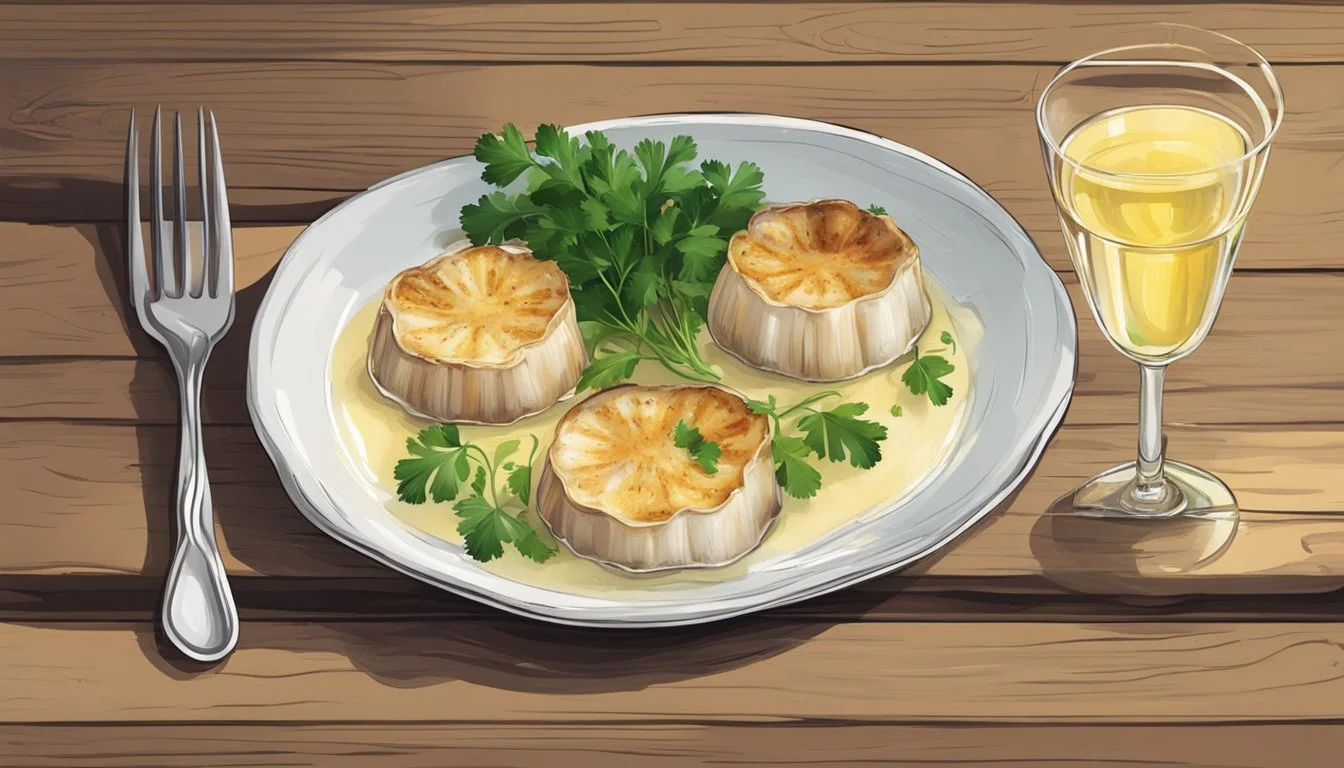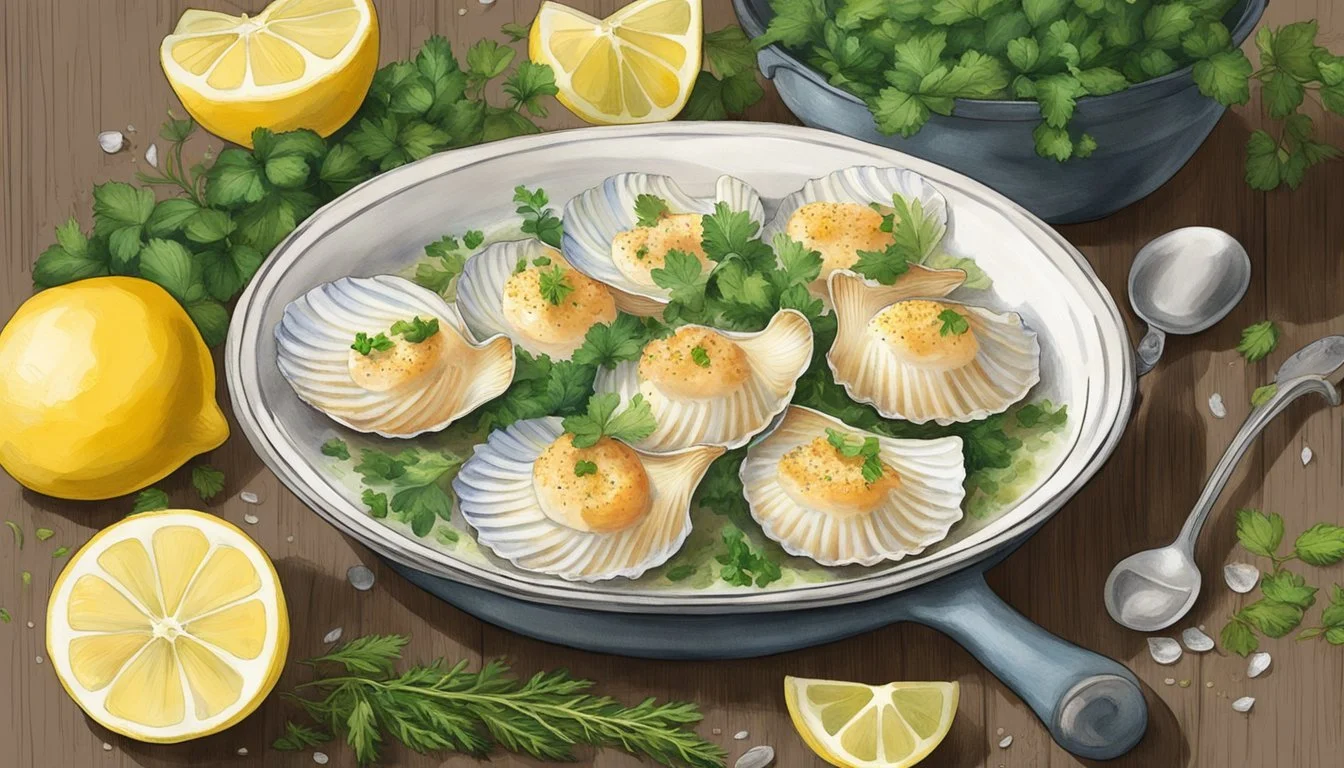Best Way to Reheat Coquilles Saint-Jacques
Ensuring Creamy Texture Retention
Coquilles Saint-Jacques, the classic French dish, is renowned for its silky creamy sauce and the delicate texture of its scallops, whether sea or bay varieties are used. Retaining this creaminess and the desired tenderness of the scallops during reheating is crucial to enjoying the dish as it was intended. The challenge lies in maintaining the integrity of the luscious sauce and ensuring that the scallops do not become rubbery or overcooked, which can easily occur with improper reheating techniques.
The secret to a successful reheat begins with understanding the components of Coquilles Saint-Jacques and their individual heating requirements. The sauce typically involves a balance of flavors and a texture that is neither too thick nor too runny, which must be preserved during reheating. Sea scallops, known for their larger size, have a more robust structure and can endure a bit more heat compared to the smaller and more delicate bay scallops. Therefore, the choice of scallops could influence the reheating approach.
Reheating Coquilles Saint-Jacques requires gentle heat and a method that evenly warms the dish without overcooking the seafood (What wine goes well with seafood?). It is also essential to cover the dish during the reheating process to lock in moisture and prevent the sauce from drying out. By carefully managing these factors, one ensures the flavor profile remains intact and the scallops emerge as tender as they were when first prepared.
Understanding Coquilles Saint-Jacques
Coquilles Saint-Jacques is a classic French dish where the choice of ingredients and the method of preparation play crucial roles in its luxurious taste and texture.
Key Ingredients for Flavor and Texture
Scallops: They are the highlight of the dish, offering a sweet and tender quality. Butter: Essential for sautéing and building the sauce, butter enriches the flavor. Gruyère Cheese: Adds a distinct nutty taste when melted on top. Lemon: A squeeze brightens the dish and cuts through the richness. Cream: Used to create a lush sauce that complements the scallops. Dry White Wine: It provides acidity and depth, enhancing the overall flavor profile. Shallots: Their subtle sharpness accentuates the other ingredients. Mushrooms: Usually sautéed in butter, they contribute an earthy element. Egg Yolk: It helps thicken the sauce, contributing to the creaminess. Breadcrumbs: Offer a textural contrast when sprinkled on top and browned.
Traditional Preparation Methods
Scallops are seared or sautéed until just cooked, keeping their succulent texture. The sauce often involves a béchamel base, enriched with cream and an egg yolk, and flavored with shallots, mushrooms, dry white wine, and a squeeze of lemon. Breadcrumbs and grated Gruyère cheese are sprinkled over the top and the dish is broiled until golden and bubbly, creating a flavorful crust that complements the tender seafood below.
Preparatory Steps Before Reheating
To ensure Coquilles Saint-Jacques retains its creaminess and the delicate texture of scallops when reheated, one must prioritize proper storage and handling. The steps outlined below are essential for preserving the quality and freshness of this seafood delicacy.
Proper Storage for Freshness
One should store Coquilles Saint-Jacques in the refrigerator immediately after it has cooled to room temperature. Using an airtight container is imperative to prevent the absorption of other flavors and smells. If long-term storage is required, freezing is an acceptable option, although it demands careful wrapping to protect the dish from freezer burn. Here are the recommended steps for refrigerating this dish:
Cool Down: Allow the dish to reach room temperature, which typically takes about 30 minutes to prevent bacterial growth.
Airtight Container: Transfer the dish to an airtight container to maintain moisture and prevent odor transfer.
Refrigeration: Place the container on a shelf rather than in the door to maintain a consistent temperature.
For frozen scallops, ensure they are wrapped tightly and placed in the coldest part of the freezer. Record the date of storage on the container for future reference.
Thawing Frozen Scallops
When Coquilles Saint-Jacques is frozen, proper thawing is critical for preserving the texture and preventing the scallops from becoming rubbery.
Refrigerator Thawing: The best method is to thaw the dish in the refrigerator 24 hours before reheating. This gradual process helps maintain the texture of the scallops.
Cold Water Thawing: If time is limited, placing the sealed container in cold water will expedite the thawing process, though it should be used as a last resort.
One must never thaw seafood at room temperature or under warm water, as it can lead to bacterial growth and spoilage. It is also crucial to cook or reheat the scallops soon after they have thawed to ensure the best quality and flavor.
Reheating Techniques
Carefully reheating Coquilles Saint-Jacques is essential to maintain its creaminess and the delicate texture of scallops. Here are the best methods for warming this classic dish efficiently.
Oven Method for Even Warmth
Using an oven can evenly reheat Coquilles Saint-Jacques without compromising texture. Preheat the oven to 350°F. If the seafood is in ramekins, they can go directly on a baking sheet. For those in shells, place them in an ovenproof dish. Cover with aluminum foil to prevent drying out, and warm for about 10 to 15 minutes or until heated through.
Stovetop Method for Quick Serving
For a quicker option, the stovetop can be employed. In a pan, gently melt a dollop of butter over low heat. Once warm, place the Coquilles Saint-Jacques into the pan. If they're in ramekins, ensure they’re stovetop safe. Heat them through for a few minutes, constantly checking to ensure they don’t overcook.
Microwave Method with Caution
A microwave might be a last resort due to its potential to unevenly heat and alter the dish's texture. If necessary, transfer the scallops, if they are not already in a microwave-safe container. Microwave on a lower power setting in short bursts of 20-30 seconds, checking between intervals. Cover with a microwave-safe lid or slightly vented plastic wrap to keep in moisture.
Enhancing Creaminess and Flavor
To preserve the luxurious nature of Coquilles Saint-Jacques when reheating, one should focus on maintaining the creaminess of the sauce and the delicate texture of the scallops. The choice of fats and careful heat management are pivotal.
Using the Right Fats
For the béchamel base, unsalted butter is essential, as it provides a rich foundation without adding unwanted saltiness that could overshadow the natural flavors of the scallops. Heavy cream should be considered over lighter alternatives because it contributes to the velvety texture that is signature to this dish.
Butter: Opt for high-quality, unsalted butter to control the salt level.
Heavy Cream: Use in lieu of milk for its higher fat content and stable emulsification properties.
Maintaining Cream Consistency
When reheating, the béchamel sauce – a mixture of butter, flour, and milk – can easily separate or become grainy if not treated with care. Gentle and even heat is crucial to ensure the sauce retains its smooth consistency. Microwaving can lead to uneven heating and potentially curdle the dairy, so slow and low is the mantra.
Flour: Acts as a stabilizer for the sauce, but must be combined with the fats correctly to prevent lumps.
Milk: Gently warm the milk before adding it to the mixture to enable a smoother blend.
One should never rush the reheating process, as a slow elevation of temperature will help the sauce to regain its creamy texture without damaging the scallops. Stirring occasionally can promote even heat distribution throughout the dish.
Garnishes and Final Touches
After properly reheating Coquilles Saint-Jacques, garnishes and final touches bring back the dish's signature elegance and enhance its flavors. Fresh herbs uplift the dish with brightness, while a breadcrumb layer adds texture contrast.
Adding Fresh Herbs
Parsley stands as a classic choice, offering a fresh, clean taste that counters the richness of the cream sauce. A light sprinkle of finely chopped parsley over the top of Coquilles Saint-Jacques not only adds color but also a touch of herbaceousness. Meanwhile, thyme provides an earthy undertone which complements the delicate flavor of the scallops. For a zesty kick, a small amount of fresh lemon zest can be added along with the herbs.
Applying the Final Breadcrumb Layer
The breadcrumb topping is a quintessential element that should be applied with precision for both texture and taste. A crisp layer, consisting of:
Golden breadcrumbs
Melted butter
Finely grated cheese (like Gruyère or Parmesan)
should be evenly spread over the Coquilles Saint-Jacques. If the dish includes an egg yolk component in the sauce, the breadcrumbs will adhere better and create a more cohesive crust. For optimal results, broil briefly until the breadcrumb-cheese mixture turns golden brown while watching closely to avoid burning.
Proper Pairings with Reheated Coquilles Saint-Jacques
When reheating Coquilles Saint-Jacques, one should select pairings that complement the dish's rich creaminess and the delicate texture of scallops to enhance the dining experience.
Suitable Wine Selections
Choosing the right wine can elevate the flavors of reheated Coquilles Saint-Jacques. The ideal pairing involves:
White Wine:
Chardonnay: A buttery Chardonnay harmonizes with the creamy sauce of Coquilles Saint-Jacques.
Sauvignon Blanc: For a zestier palate, a crisp Sauvignon Blanc can cut through the richness, balancing each bite.
Complementary Side Dishes
Side dishes should complement the main course without overpowering it. Here are some suitable options:
Vegetables:
Asparagus: Lightly sautéed with garlic and Parmesan, asparagus offers a fresh counterpoint.
Green Salad: Dressed with a vinaigrette incorporating lemon juice, a green salad adds a crisp, acidic touch.
Starches:
Rice: A subtle lemon zucchini risotto supports the main dish’s flavors without competing with them.
Bread: Crostini, toasted and rubbed with garlic, provide textual contrast to the creamy, tender scallops.
Serving Suggestions
When reheating Coquilles Saint-Jacques, the serving suggestions play a crucial role in preserving the dish's quality. One must choose the right dishware and present the dish with care, ensuring the scallops' creaminess and texture are forefront and the experience is reminiscent of the dish's initial elegance.
Choosing the Right Dishware
The selection of dishware is paramount for serving Coquilles Saint-Jacques as a first course or main course. It is traditional to serve the dish in ramekins or scallop shells, which not only provide aesthetic appeal but also assist in even reheating and maintain the desired temperature longer.
First Course: Shallower ramekins work best, providing enough space for an appetizing portion without overwhelming the rest of the meal.
Main Course: A deeper ramekin can be used to accommodate a larger portion that befits the hearty appetite expected for the centerpiece of the meal.
Presentation Tips
A visually appealing presentation is vital to imbue the dish with a sense of bon appétit. The creamy texture of the sauce and the delicate scallop should appear sumptuous and inviting:
Texture Hint: A quick garnish of thinly sliced leek on top can add a contrast in texture and a mild oniony flavor that complements the dish.
Color Contrast: If the dish features a pale sauce, include a sprig of fresh herbs to introduce greenery and enhance the visual contrast.
By focusing on the right dishware and a thoughtful presentation, one ensures that Coquilles Saint-Jacques is not just reheated but revived with respect to its creamy integrity and sumptuous texture.
Troubleshooting Common Reheating Issues
Ensuring that Coquilles Saint-Jacques is reheated properly can maintain its rich flavor and desired texture. The dish's creaminess and the scallop's delicate structure make it susceptible to common reheating issues such as overcooking and sauce separation.
Avoiding Overcooking Scallops
Scallops: They are easily overcooked which can result in a rubbery texture.
Solution: Reheat only until scallops are warm to the touch; typically for approximately 10 minutes at 350°F (175°C).
Tip: Use a thermometer to check the internal temperature, which should not exceed 125°F (52°C).
Preventing Sauce Separation
Creamy Sauce: Can break or separate when reheated incorrectly.
Solution: Warm the dish gently over low heat, stirring often to prevent the sauce from overheating and separating.
Useful Practice: Incorporating a small amount of seafood stock while reheating can help maintain the sauce’s consistency.
Food Safety Considerations
When reheating Coquilles Saint-Jacques, it is crucial to observe food safety protocols to prevent foodborne illness. Seafood, particularly scallops, are highly perishable, so proper handling and storage before reheating is essential.
Firstly, expiration dates on all seafood should be checked before preparation and consumption. If the Coquilles Saint-Jacques has been stored in the refrigerator, it should be consumed within one to two days, while frozen variations should be used within three months for optimal quality.
Before reheating, ensure that the scallops and sauce have been stored at the right temperature. The U.S. Food and Drug Administration (FDA) recommends keeping cold seafood at or below 40°F and hot seafood at or above 140°F. Here are specific guidelines:
Refrigeration Temperature: 32°F to 40°F (0°C to 4.4°C)
Freezer Temperature: 0°F (-17.7°C) or colder
For safe reheating, bring the Coquilles Saint-Jacques to an internal temperature of 145°F (62.8°C), measured with a food thermometer. Avoid repeated reheating, as this increases the risk of harmful bacteria growth.
Cross-contamination is another factor to consider. Use clean utensils and surfaces when handling Coquilles Saint-Jacques to prevent the spread of bacteria from raw to cooked foods.
Finally, those with compromised immune systems should exercise extra caution, as the risk associated with consuming improperly handled seafood is greater.
Do Don't Check expiration dates and consume in a timely manner Reheat if seafood has been left out at room temperature for more than 2 hours Store at the correct temperatures Overlook cross-contamination risks Reheat to an internal temperature of 145°F Reheat multiple times
Observance of these straightforward food safety protocols will help ensure the Coquilles Saint-Jacques are safe to enjoy a second time.








